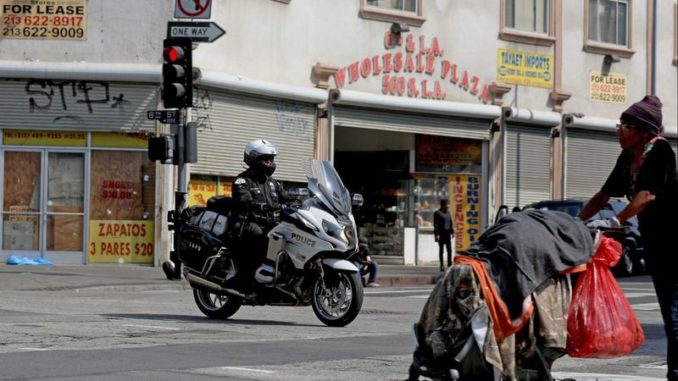
LAPD officers are now showing signs of typhoid fever and a “typhus-like” illness in rat-infested Los Angeles.
According to multiple reports, Los Angeles is on the verge of a major infectious disease epidemic in the coming months, due to the overwhelming amount of homeless people, unsanitary conditions and rotting trash.

BYPASS THE CENSORS
Sign up to get unfiltered news delivered straight to your inbox.
You can unsubscribe any time. By subscribing you agree to our Terms of Use
Latest Video
So far, at least six LAPD officers from the same downtown precinct are showing signs of typhoid fever after working near the city’s growing homeless emcampment.
Dailywire.com reports: Late last week, radio host Dr. Drew Pinsky made headlines declaring that Los Angeles is the epicenter of a “public health emergency” stemming from a growing homeless population that finds nothing wrong with setting up permanent encampments across large swaths of the city’s downtown area, and cautioned that, unless city officials took immediate action, it’s likely the homeless population in LA could see an outbreak of the bubonic plague.
The plague, of course, killed tens of millions across Europe in the 14th century, before the advent of public sanitation and clean water systems. But as Pinksy recalled to Fox News host Laura Ingraham last week, Los Angeles is suffering from a complete lack of a sanitation strategy, and just as these serious communicable diseases seem to be taking root, the city council is considering a ban or moratorium on using rat poison.
The six LAPD officers include at least one detective who has already been diagnosed with typhoid fever. The city’s police union announced late Saturday that five others are showing symptoms of the same rare illness.
Typhus and typhoid fever are spread through contaminated food and water, and through fleas and ticks. The six officers, who work at the city’s Central Division Station, may have come in contact with the disease while policing the city’s growing homeless encampments — particularly on Skid Row, which is in the Central Division’s district — or simply from interacting within the station itself. A state investigation into conditions in and around the Central Division Station, the Associated Press reports, turned up a myriad of public health issues, landing the building a $5,000 fine and an order to clean up immediately.
But the city’s police officer’s union says it isn’t that simple. Los Angeles needs to get serious about breaking up homeless encampments — even if they feel a sense of progressive empathy over them — before they become a widespread public health hazard.
In addition to typhus and typhoid fever — and potentially the plague — officers of LAPD’s Central Division Station contend routinely with cases of Hepatitis A and staph infections, a union spokesperson said in a press conference Saturday.
“The last thing I need is my members coming to work worried about contracting an infectious disease and bringing it home to their families,” the spokesperson told reporters.
Infectious disease experts told the Associated Press that conditions inside the station would have had a marked effect on the spread of illnesses like typhus. The police union agrees and believes the city of Los Angeles should make keeping police officers safe and improving their working conditions at top priority.
Los Angeles, of course, isn’t the only city facing these kinds of problems — and it certainly isn’t the first time Los Angeles has faced typhus and typhoid fever. Several years ago, when the homeless population temporarily exploded, LA faced a small outbreak of the disease that led to a massive cleanup. This time around, though, like its sister city, San Francisco, California, Los Angeles’ city government isn’t chomping at the bit to address the root cause of the problem: rampant homelessness.
In San Francisco, there is a similar threat of disease, particularly given that sidewalks and public ways across the city are littered with human waste, and the homeless encampments there have gotten so crowded that some members of the transient population are now building makeshift boats so that they can live in San Francisco’s famous bay.


